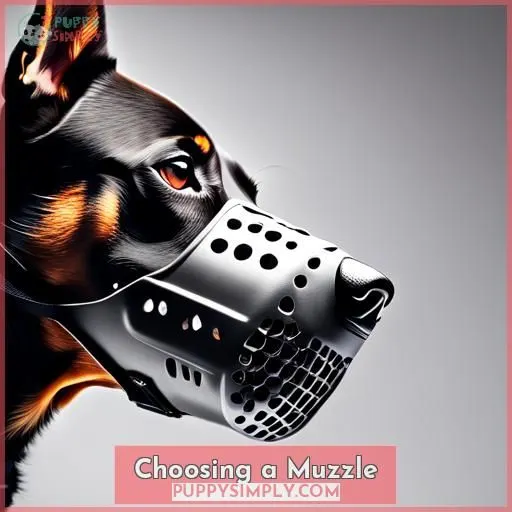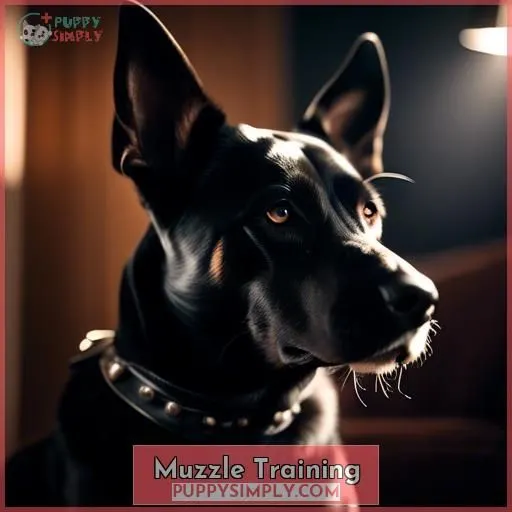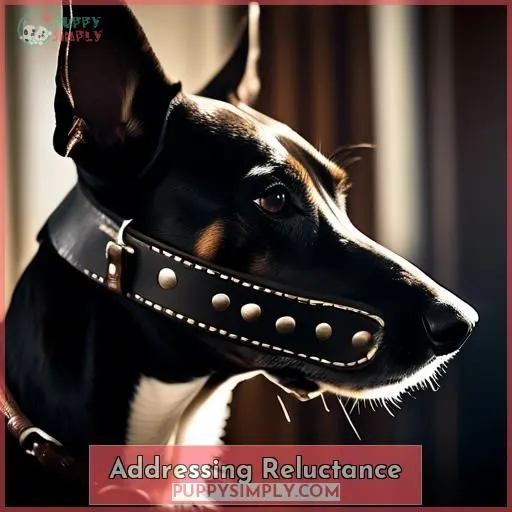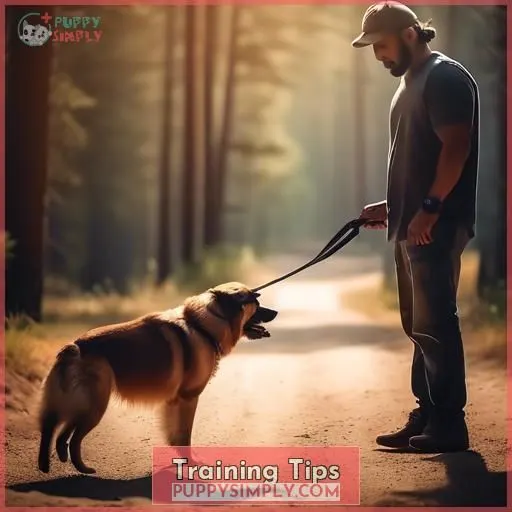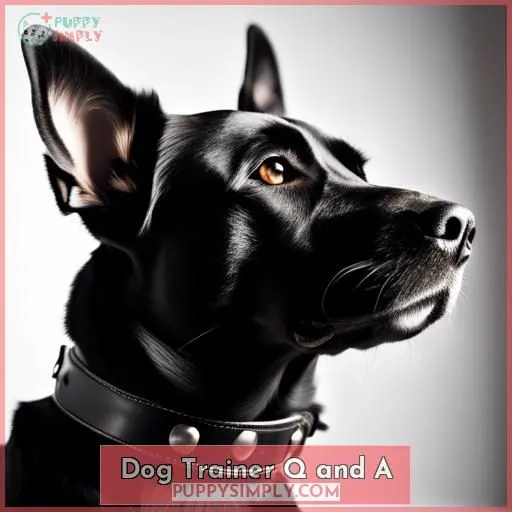This site is supported by our readers. We may earn a commission, at no cost to you, if you purchase through links.
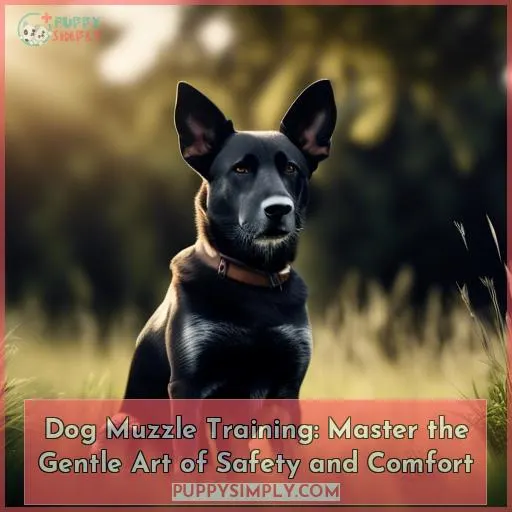 Proper dog muzzle training is essential for safety and creating a positive association.
Proper dog muzzle training is essential for safety and creating a positive association.
Start by selecting a comfortable, well-fitted muzzle that allows panting and treat rewards.
Use positive reinforcement techniques – reward your pup for each small step with treats and praise.
Gradually introduce the muzzle in a favorable context through desensitization and counter-conditioning.
With patience and consistency, you’ll master the gentle art of dog muzzle training, ensuring your furry friend feels secure and at ease.
Want to explore this important skill further? Keep reading to uncover invaluable insights on establishing a trusting bond while prioritizing comfort and safety.
Table Of Contents
Key Takeaways
- Proper dog muzzle training is essential for safety and creating a positive association.
- Start by selecting a comfortable, well-fitted muzzle that allows panting and treat rewards.
- Use positive reinforcement techniques, such as treats and praise, to encourage your pup to accept the muzzle.
- Gradually introduce the muzzle in a favorable context through desensitization and counterconditioning.
Types of Muzzles
As a conscientious dog owner, you desire to safeguard your beloved companion’s well-being. Muzzles are an indispensable tool in achieving this objective, offering an array of advantages from preventing bites in urgent situations to controlling aggressive behavior**. However, with the diverse selection of muzzles available, how do you discern the most efficacious one for your dog?
Firstly, contemplate the breed and intended muzzle application. For example, basket muzzles are optimal for dogs that require panting, eating, and conveying body language cues. Conversely, sleeve muzzles limit panting and signaling and are most appropriate in emergencies for brief durations. Muzzle materials also bear significance in long-term muzzle management; choose those that are comfortable and secure, such as pliable muzzles that encase the mouth.
Improvised muzzles may suffice in emergencies but aren’t suitable for prolonged use. Always prioritize the canine’s safety and comfort when selecting a muzzle. Recall, the ultimate aim is to foster a harmonious bond between the dog and the muzzle, ensuring a positive experience for both.
Choosing a Muzzle
You’ll want to choose a muzzle that fits snugly without restricting panting or causing discomfort. Consider the dog’s size, jaw structure, and intended purpose – basket muzzles allow drinking and treat rewards, while sleeve muzzles serve for brief restraint. With positive reinforcement training, you can ensure your pup associates the properly fitted muzzle with pleasant experiences.
Muzzle Fit and Comfort
Selecting the appropriate muzzle for your dog is paramount for their well-being and security. A well-fitting muzzle should deter bites while allowing your dog to breathe and consume treats. It shouldn’t cause discomfort to the nose or eyes, nor should it be excessively tight or loose. To achieve an optimal fit, take into account the length and width of your dog’s muzzle. Certain muzzles are designed for specific breeds or facial configurations, therefore custom-made options may be necessary for a perfect fit.
When choosing a muzzle, consider the material and its potential impact on your dog’s skin. Hard materials such as plastic or metal may cause irritation, while softer materials such as leather or fabric are typically more comfortable. Additionally, consider the ease of feeding through the muzzle, as some designs restrict panting and eating.
Muzzle training should be conducted incrementally, utilizing positive reinforcement. Commence with brief sessions in an environment free of distractions, and gradually introduce the muzzle, encouraging your dog to enter it. Always supervise your dog during training and ascertain that they’re comfortable wearing the muzzle.
Muzzle Type Selection
Selecting the appropriate muzzle for your canine companion is paramount for maintaining safety, comfort, and efficient training. Consider the following factors when making your choice:
- Materials: Opt for muzzles constructed from malleable and comfortable materials such as rubber or neoprene for a secure and adjustable fit. Some muzzles are also available in leather, which can provide enhanced comfort for your dog.
- Colors: Muzzles come in a range of hues, including black, tan, and clear. Select a color that complements your dog’s coat and personal preferences.
- Durability: Seek out muzzles that are robust and durable, yet flexible enough to allow for panting and drinking. High-strength Thermoplastic Rubber (TPR) is a popular choice due to its durability.
- Cleaning: Choose a muzzle that can be easily cleaned and maintained. Some muzzles can be warmed and shaped to provide a more customized fit, while others may require specific cleaning instructions.
- Storage: Consider how the muzzle will be stored when not in use. Some muzzles are accompanied by a carrying case or pouch for convenient storage and transport.
- Size: Select a muzzle that’s appropriately sized for your dog’s breed and weight. Measure your dog’s snout length and circumference to determine the optimal size.
- Customized Options: If your dog has an unusual face shape or size, consult a professional for guidance on customized muzzles.
When selecting a muzzle, prioritize safety, comfort, and ease of use for both you and your dog.
Positive Training Techniques
To ensure a successful muzzle training experience, positive reinforcement is essential. Reward your dog with treats, praise, or gentle petting for each step they take in accepting the muzzle. Start with desensitization and counter-conditioning techniques, gradually introducing the muzzle in a favorable context.
Employ appropriate rewards and training methods to make the process enjoyable and stress-free. Remember, the goal is to create a positive association with the muzzle, not to punish or induce fear.
Muzzle Training
Muzzle training is a vital part of ensuring the safety of your furry friend and those around them. It’s not just about preventing bites in emergencies, but also ensuring safety during behavior modification, managing aggressive behavior, facilitating handling during veterinary exams, and preventing self-harm or destruction.
The key to successful muzzle training lies in using positive reinforcement techniques.
Start with short sessions in a distraction-free environment.
Gradually introduce the muzzle while encouraging entry.
Instead, they prioritize safety for both dogs and humans.
Always seek professional guidance when choosing a muzzle.
Follow a well-structured training plan, like the one provided by the Muzzle Up! Project.
Addressing Reluctance
Regarding muzzle training, managing hesitations is vital. Should your dog exhibit signs of apprehension or unwillingness, it’s imperative to honor their emotions and implement a gradual, patient approach. Here’s how to handle muzzle reluctance:
-
Avoid Persuasion or Enticement: Refrain from coercing your dog to don a muzzle. Such actions can evoke negative associations with the device. Instead, allow your dog to approach the muzzle at their own pace.
-
Suspend Training If Needed: If your dog becomes fearful or anxious during training, discontinue the session. Training can be resumed when your dog is more at ease.
-
Seek Expert Assistance: Should your dog’s reluctance persist, consider seeking professional guidance. A qualified canine behaviorist can offer insights into more effective training approaches.
Training Tips
To safeguard your dog’s well-being and ease while utilizing a muzzle, contemplate these training recommendations:
- Muzzle Security: Continuously monitor your dog while donning a muzzle, particularly during the initial phases of training. Verify that the muzzle is appropriately fitted and fastened to deter bites and escape attempts.
- Muzzle Ease: Progressively accustom your dog to the muzzle, commencing with brief sessions in an environment devoid of distractions. Reward your dog with treats and commendations for each advancement they make towards embracing the muzzle.
- Muzzle Acclimatization: Desensitize your dog to the muzzle by incorporating it into their daily regimen. This may entail wearing the muzzle during strolls, playtimes, and even at their abode.
- Muzzle Practice and Integration: Engage in practicing the use of the muzzle in various directions and settings to assist your dog in familiarizing themselves with it. Integrate your dog with other dogs while they’re wearing the muzzle to foster their understanding that it’s an ordinary aspect of their existence.
Dog Trainer Q and A
Regarding muzzle training, the knowledge of dog trainers can offer valuable insights and methods. In our dog trainer Q&A, we explore the sphere of muzzle safety, emergency use, and training techniques with two respected experts: Jean Donaldson and Heidi Steinbeck, CTC, CPDT-KA.
Jean Donaldson, a prominent figure in the dog training community, shares her views on the significance of muzzles in different scenarios. She highlights that muzzles aren’t exclusively for aggressive dogs but can also be employed in emergencies, such as when a dog is injured or frightened. Donaldson believes that muzzles can provide reassurance in potentially hazardous situations, even for dogs with no history of biting.
Heidi Steinbeck, a certified dog trainer, contributes to the discussion by examining the role of positive reinforcement in muzzle training. She suggests initiating with brief sessions in a distraction-free environment and progressively introducing the muzzle, encouraging entry, and practicing in various positions and locations. Steinbeck also emphasizes the importance of gradually increasing duration and incorporating commands.
In terms of addressing reluctance, both trainers agree that coaxing or tempting should be avoided, and dogs should be respected in their hesitation. If a dog becomes fearful during training, it should be discontinued, and professional assistance may be sought if necessary.
Regarding muzzle selection, both trainers emphasize the importance of fit, comfort, and positive training methods. They recommend basket muzzles for their ability to allow panting, eating, and body language signals, while sleeve muzzles should be used only in emergencies for short durations due to their restrictive nature.
Frequently Asked Questions (FAQs)
What is the difference between basket and sleeve muzzles?
Basket muzzles allow your pup to pant, eat treats, and give kisses, while sleeve muzzles restrict those activities. For everyday safety, go with a comfy basket muzzle – your furry friend will thank you!
How do I know if my dog needs a muzzle?
You’ll need a muzzle if your pup has nipped before or seems uncomfortable in certain situations. It’s a safety precaution, not a punishment. With proper training, a well-fitted muzzle can give you both peace of mind without restricting normal doggy behavior.
Can I train my dog to wear a muzzle without using treats?
You could, but it’s not recommended. Treats help make muzzle training positive and build a great association. Without them, your pup may resist or feel stressed about wearing one, undoing your hard work. Stick to tasty rewards – they’re key for success!
How long should I train my dog to wear a muzzle each day?
Start slow with just 5-10 minutes daily. You’ll gradually increase duration as your pup gets comfortable. There’s no rush – consistency and positive reinforcement are key. Let your dog’s progress guide the training pace.
What should I do if my dog becomes aggressive when wearing a muzzle?
If your pup gets agitated with the muzzle, don’t force it. Stay calm, remove the muzzle, and consult a professional trainer to guide you through proper desensitization. Rushing this process could worsen aggression, so take it slow and put your dog’s comfort first.
Conclusion
Mastering dog muzzle training opens a realm of safety and solace for your beloved canine. Through patience, positive encouragement, and a snugly fitted muzzle, you’ll foster trust, soothe anxiety, and build a haven of security. Embrace this gentle practice, ensuring your pup feels at peace, self-assured, and shielded during every shared adventure.


